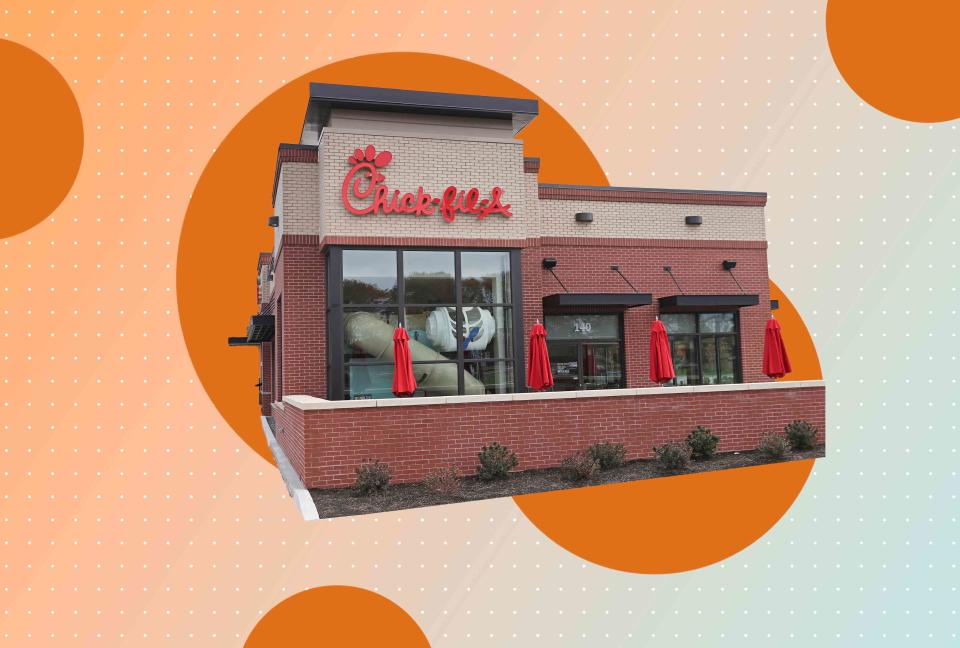Chick-fil-A Just Announced Its Chicken Will No Longer Be Antibiotic-Free: Here's What That Means
Could this be a good thing?

Getty Images
Reviewed by Dietitian Maria Laura Haddad-Garcia
If you’re a fan of Chick-fil-A, it might be because of the taste of their juicy, marinated, spiced-just-right fried chicken or their crispy waffle-cut French fries. You might also like their pledge to serve chicken that wasn’t treated with antibiotics.
But some of this is changing.
Chick-fil-A just announced that they would no longer be serving chicken that was given No Antibiotics Ever (NAE) and is switching to No Antibiotics Important to Human Medicine (NAIHM) chickens. "NAE means no antibiotics of any kind were used in raising the animal. NAIHM restricts the use of those antibiotics that are important to human medicine and commonly used to treat people, and allows the use of animal antibiotics only if the animal and those around it were to become sick,” reads the statement.
Related: What Happens to Your Gut When You Take Antibiotics, According to a Gastroenterologist
What Does This Mean?
Starting in the 1950s, it became common practice for farmers to give chickens antibiotic-laced feed, whether they were sick or not. The antibiotics kept illness at bay in chickens who often lived in cramped growing conditions. It also had the added benefit of the chickens growing at a faster rate, according to a 2023 study in the journal Microbiome.
Despite some of the benefits of feeding chickens antibiotics, there became pervasive evidence of its detriments in the 1970s. And while the FDA initially announced it would start banning the use of antibiotics in this way, it caved to the pressure of certain groups and continued business as usual—until about 2011, when public health experts yet again began to voice their concerns about the overuse of antibiotics in livestock, per a 2015 article in The American Journal of Public Health. At that time, about 80% of all antibiotics sold in the U.S. were for use in animal agriculture. And about 70% of those were antibiotics that are important in treating human illness.
What’s the big deal?
According to research, like the 2021 study in Infection and Drug Resistance, there is strong evidence that regularly eating poultry and meat that have been treated with human antibiotics can cause antibiotic resistance—aka antimicrobial resistance—meaning, your body can build up a tolerance to the medication. When this happens, if you were to get sick and needed an antibiotic, it might not work. And this could have serious consequences.
In fact, according to the Centers for Disease Control and Prevention (CDC), in the U.S., more than 2.8 million antimicrobial-resistant infections occur each year—and more than 35,000 people die as a result. The numbers just go up from there globally, with at least 1.27 million deaths caused by antimicrobial-resistant infections each year. These numbers are what caused the CDC to declare antimicrobial resistance as an urgent global public health threat.
For this reason, in 2015, the use of human antibiotics in chickens (and more recently in beef and pork) became a more limited practice when the Antibiotic Resistance Action Center (ARAC) raised its standards and began certifying chicken farms. Certified Responsible Antibiotic Use (CRAU) poultry producers “are prohibited from using antibiotics with analogues in human medicine routinely or without clear medical justification, and such use must be rare, well documented, and prescribed by a veterinarian,” per the USDA.
As this issue became more prominent in the news, consumers started voicing their concerns and demanded greater access to antibiotic-free chicken. So many companies, including Chick-fil-A, followed suit.
But Chick-fil-A’s latest stance is that they will now be using chickens that may have been treated with animal antibiotics if they were sick or were part of a flock in which an illness was going around.
In other words, Chick-fil-A chickens aren’t going to have human antibiotics—like amoxicillin or erythromycin, which are used to treat infections like pneumonia or urinary tract infections— tossed into their chicken feed. Only antibiotics that are suitable for animals will be used and only when necessary—they will not be used prophylactically to prevent infection.
But this does raise the question: Do we want to be eating chicken that has been sick, even if they were given medication to cure the illness?
It shouldn’t be a problem, says Marion Nestle, Ph.D., M.P.H., as long as the chicken is cooked properly. “The concern is human exposure to pathogenic bacteria resistant to antibiotics,” says Nestle.”In that case, the antibiotics would not work. It’s the bacteria that create the hazard, not the antibiotics on their own.”
If the chicken was treated with animal antibiotics, the USDA requires a “withdrawal” period to ensure that no antibiotic residues are hanging out in the chicken before it’s slaughtered. The birds are randomly sampled to test for antibiotic residues, bacteria and other pathogens. The USDA states that data from this monitoring program shows a very low percentage of residue violations.
What’s Not Changing with Chick-fil-A Chicken?
Chick-fil-A’s recipes aren’t changing, and you’ll still be able to get all your favorite menu items, from their grilled and fried chicken sandwiches, strips and nuggets to their sides, including fries, soups, salads and yogurt parfaits. And Chick-fil-A stresses that they remain committed to providing the highest-quality chicken that, according to them, still exceeds industry standards. They continue to serve only real, white breast meat with no added fillers, artificial preservatives, steroids or hormones.
Related: Clean-Eating Buyer's Guide to Chicken
Read the original article on Eating Well.

